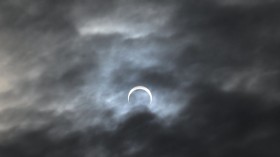Two deaths and 19 injuries resulted from a pair of lightning strikes just this weekend, reminding us how dangerous thunder storms can be. But just how much do we actually know about lightning? Nature World News drags these deadly flashes of electricity into the spotlight.
Last Friday, Rebecca R. Teihet, 42, was struck and killed by lightning during a severe storm over the Ute Crossing Trail in Rocky Mountain National Park. Seven others were also injured from the strike, according to the National Park Service (NPS). The following day, lightning did strike twice, unfortunately killing Gregory Cardwell, 52, around the park's Rainbow Curve. The strike also injured at least 12 others, according to The Weather Channel.
A War in the Sky
The NPS says that such incidents can serve as a stern warning to keep a wary eye on weather reports, especially before heading into elevated areas during storm seasons. However, they also may remind us how little we actually know about lightning.
When clouds go from being harmless cotton balls to ominous sheets or darkness, a war is actually being fought beneath their fluffy exterior. Gravity and rising warm air fight over ice and water particles within clouds, rubbing them into one another faster and faster, creating static electricity just like you would when rubbing a balloon. Imagine a vast swath of clashing clouds all full of rubbing balloons - that's a lot of static building up with nowhere to go.
Then, in a mysterious process still scarcely understood, positive and negative charges within the clouds separate, firing up and down, respectively. As the negative charge races down, it searches for neutrality, striking the closest conductor so that it can race to a positive charge from the Earth.
The charge is remarkably hot, creating a dangerous shockwave through the air as it struggles to reach the Earth. If a person were to get in the way... things do not turn out well.
Charges will also streak within and between clouds, causing the brilliant displays storm chasers love to photograph.
Five Ways to Get Struck
If a person is unlucky enough to be caught in a storm, there are five different ways he or she can be struck:
A direct strike - straight from a cloud to a person - is predictably the most deadly but thankfully the most uncommon. When this occurs, the immense amount of electricity in a strike will flow over (called a flashover) the body causing severe burns. The greater concern, of course, is the electricity that will inevitably flow through the body - overwhelming the heart and nervous system. If you have a pacemaker, you can kiss it goodbye.
More common is the "side flash" - when electricity literally splashes off an object struck (like a tree) and jumps to a nearby person. These can be survived but still cause severe flashover.
Conduction and ground current strikes can also affect a person. Conduction is simple. You're holding a metal door frame? Your house got struck by lightning? Big zap incoming. Ground current strikes take this concept and complicate things. If the ground is saturated with enough ground water or conductive minerals, a lightning strike might not immediately dissipate into the ground and may travel to other nearby objects - like an unlucky hiker. These kind of strikes most commonly kill livestock and can stretch out up to some 60 feet.
Lastly, there's streamers. Not as common as other types of lightning strikes, streamer strikes occur when charges from the ground rise, completing a brief "circuit" of electricity that we physically see streaking between the sky and ground, called a return stroke. Some streamers aren't directly involved in a return stroke, but a person unlucky enough to get caught in the charge can still be killed or injured in an uncompleted lightning channel. This bizarre phenomenon looks like a spike of lighting shooting from the ground.
One Flash, Twice Struck
According to the National Weather Service, a 1998 study revealed that the old adage "lighting never strikes twice" is actually completely wrong - a least in a technical sense.
Tests carried out by experts in the United States and Japan found that when a lighting flash finally reaches Earth, it often strikes more than one place at once, with forked endpoints causing damage at multiple sites.
According to the study, at least half of negative flashes and more than 70 percent of positive flashes - complete with dangerous streamers - have forked endpoints. Unfortunately, even modern lightning detectors have trouble measuring multiple ground lightning attachments and the exact statistics for this phenomenon remain unclear.
What the Heck is Ball Lightning?
Now here's something that's just cool. Imagine you're sitting under a pavilion, taking shelter from a thunderstorm, when a golf ball-sized bit of dancing white light floats into your view and starts to skitter across the floor. Once it reaches the other side of the pavilion, the mysterious orb ascends into the sky once more and disappears.
Graham K. Hubler saw this very thing one stormy day when he was 16 years old.
"It's extraordinary - you're so startled that you remember it for the rest of your life," he told National Geographic.
Hubler said the orb behaved as if it had a charge and was following electric field lines along the Earth; and he should know, he's a physicist at the US Naval Research Laboratory in Washington, D.C. This close encounter caused Hubler to believe that he is one of the countless people who think they've seen ball lightning.
"I remember telling people what I had seen, and they thought I was crazy, so I stopped talking about it," he said.
But young Hubler wasn't crazy. In 2012, researchers finally confirmed the existence of this mysterious phenomena with hard data after taking readings of a lightning ball that formed near a spectrometer completely by chance.
Researchers had been studying ordinary cloud-to-ground lightning strikes when they physically saw a glow of ball lighting about five meters across. Spectronomy readings later revealed that the physical size of the ball was much smaller, and remarkably made of soil.
"This one certainly seems to be made of dirt," said lightning specialist Martin Uman, commenting on a study of the data. "I think that this is a unique observation that is probably of ball lightning, or one type of ball lightning."
Uman goes on to explain that the data supports a pre-existing theory that mineral atoms from upheaved soil can temporarily hold a persistent charge, causing a ball of them to float and potentially even explode with electricity.
The authors of the study write that they will attempt to recreate ball lightning in a lab in the future in order to confirm the phenomenon.
The study was published in Physical Review Letters on January 17.
Additional information on lightning strikes from the National Weather Service.
© 2024 NatureWorldNews.com All rights reserved. Do not reproduce without permission.





